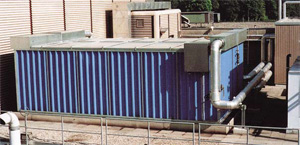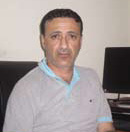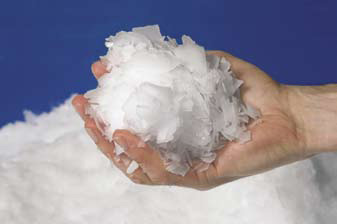According to industry estimates, thermal energy storage can eliminate chiller capacity by up to 25-30%. So what’s holding it back in the region, then? Jose Franco has the story.
According to industry estimates, thermal energy storage can eliminate chiller capacity by up to 25-30%. So what’s holding it back in the region, then? Jose Franco has the story.

An ice thermal storage system | Imec Electromechanical Engineering
Saying no to certain products is, in some cases, brought about by not having enough information on the benefits they offer. Or maybe some wrong information is being put across, or there is just a refusal on the part of customers to know more about the products that could jack up capital expenditure.
Why would a company embrace thermal energy storage (TES), for instance, if this meant additional costs for TES tanks? The initial notion that a tank would eat up more space than it should and spoil the design aesthetics in surrounding areas could also be reasons why some project owners and developers had stayed away from TES.
“Maybe they don’t realise the importance of having a TES tank,” says Fadi Hachem, Mechanical Engineering Manager at DC Pro Engineering. A Dubai project having a TES tank actually eliminates about 20% of the chiller capacity in district cooling, thereby saving on MEP spending.
DIFFERENTIAL TARIFF
And yet some would argue that the absence of a differential-tariff system in the Gulf is a major factor why the regional industry has been lacklustre in embracing TES. “They say build TES, but what is the benefit if there is no differential tariff?” asks Adib Moubaddir, General Manager of EMICOOL. He is referring to the power and water authorities that have increasingly been asking owners and developers to embrace TES in their projects that call for district cooling systems.
He says the Dubai Electricity and Water Authority (DEWA), the Abu Dhabi Water and Electricity Authority (ADWEA) and other utility regulators, especially in Saudi Arabia, should talk to one another regarding tariff differential. “People don’t understand that district cooling is a utility and service provider,” he adds.
A demand-side management where the price per unit of energy varies with time of use, differential tariff is being recommended by industry experts and consultancies, so the region can reflect higher prices for power consumption during peak loads. Moubaddir remarks, “If a government stands and says it will support district cooling companies, there will be price segmentation.”
District cooling, which involves the provision of cooling to multiple facilities from one or more central cooling plants, and TES complement each other in HVACR markets. Referring to technologies that store energy in a thermal reservoir for later reuse, TES helps balance energy demand between daytime and nighttime.
These technologies are applied in the production of ice, chilled water or eutectic (a mixture of chemical compounds that solidifies at a lower temperature) solution at night, when demand for energy is lower. Whilst a partial storage system reduces capital investment by running the chillers 24 hours a day, a full storage system minimises energy costs by shutting off the chillers during peak-load hours.
PAYBACK TIME
The advantages in embracing TES are self-evident in the MEP sector, as these shave off peak demand through system design and reduce to the right level the size of plant rooms. But the return on investment becomes an issue, especially with the financial crisis, says Aslan Al Barazi, Executive Director of IMEC Electromechanical Engineering. He emphasises that product manufacturers and contractors will experience resistance from customers to embrace TES, if payback time is not immediate.
“If you don’t, then value engineering proposals at a later stage in the project normally kills the subject,” he stresses. “Of course, if and when the dual tariff system is applied, it would then turn the TES commercial proposal from a long-term to a short-term payback time, and will thus make it commercially feasible and very attractive.”
It is no wonder, he says, that TES and, particularly, ice thermal storage technology, are widely used in normal applications in the US and Europe, especially in cities where space is at a premium. Ice storage takes only one-tenth of the space needed for water thermal storage, although it consumes more energy.
The Dubai-based sales area manager of Baltimore Aircoil Gulf, Frank van Leemput, favours the dual tariff for air conditioning facilities during the three summer months, where a peak tariff imposed from 1pm to 5pm shall make energy consumption more costly. Industries will, then, opt to produce and store cooling power during cheap hours and use it when the cost of energy consumption is higher.
In an energy-management programme, chilled water/thermal ice storage systems are installed in office or manufacturing complexes to make ice during off-peak-demand periods at night. The systems will, then, melt the ice during the day, when demand for cooling power is higher, to serve the HVAC and process loads in the buildings.
The Texas Instruments’ facility in Massachusetts, for instance, was able to report annual savings of up to $460,000 when it installed two chilled water/thermal ice storage systems in two of its buildings between 1994 and 1996. The systems were able to shift 1.1MW of peak demand to off-peak periods, helping to level the facility load factor.
GROWING MARKET
Savings on annual consumption of electricity could be enough reason, though there are other factors, for property developers and owners to embrace TES. “It’s becoming almost a standard,” Hachem says of the TES technology that’s gaining popularity.
He and Al Barazi share the opinion that there is a growing market for TES in the region. The former cites the UAE (particularly Abu Dhabi), Saudi Arabia and Qatar as emerging markets whilst the latter stresses the technology’s huge potential, especially on non- district cooling applications, “where the attention should be drawn next”. Al Barazi says most projects these days are non-district cooling in nature due to the economic downturn.
These days, TES tanks are also being designed in a way that they would blend well with other buildings in a manufacturing complex and not compromise the aesthetics angle of the whole vicinity, Hachem says. Also, the tanks are compact enough not to eat up so much space, as they are designed to last for at least 25 years.
The Sharjah-based DC Pro Engineering has contributions in 18 TES projects that have an overall capacity of 760,995 tonne-hours. These projects – Dubai Investments Park DCP 1 and 3 (98,000 tonne-hours), Al Sowwah Island (54,000 tonne-hours) and Sharjah Investment Centre (132,000 tonne-hours), to name a few – are either operational, on hold, in the design stage, at tender stage, under construction or being commissioned.
“Now, people realise the advantages of TES in the design of their district cooling systems, and the technology is becoming a standard for all new plants,” Hachem says.
By the end of the year, he adds, DEWA may issue a regulation on the proper use and implementation of district cooling plants with TES. This would be the first such regulation amongst countries in the Gulf Co-operation Council, though it could come as no surprise. Dubai was the first in the region to issue an executive order that calls for the utilisation of TES, aiming to help reduce power demand.
Whilst Abu Dhabi doesn’t oblige district cooling applications to have TES at 20% of the total plant room capacity like Dubai does, Al Barazi says, district cooling clients in the capital still use TES, because extra land permits there are less costly compared to those in the neighbouring emirate. But he says that for standard buildings, or non-district cooling applications, the scenario could be different. “There, TES is not widely used and may be subject to client preference, green buildings perspective, peak demand cooling load profile and other reasons,” he adds.
NOT IN THE PIPELINE
These days, however, developers in either emirate may not opt for TES, owing to the economic slowdown, if we are to go by the words of Nabil Helou, Managing Director of Amana Pipeline Construction. “I don’t think the developers have the money to do this,” he says, noting the severe slump in the real-estate business. He says, for instance, that the rent around Al Barsha 1, where his office is located, is now at $24.50 (Dh90) per square metre compared to $76.23 (Dh280) per square metre one and a half years ago.
If it is, indeed, money that’s holding the industry back from fully embracing the TES technology, perhaps regulators could help by implementing the differential tariff system. “The developers want to reduce their capital upfront,” Helou says. The government, therefore, has to provide enough incentives to make TES more enticing. He suggests that utility regulators study the tariff system in mature countries, such those in Europe, and see how this can be applied in the UAE and other Gulf countries.
He is optimistic about the other parts of Amana’s operations, however, despite being convinced that the UAE economy will only pick up by 2013. TES only accounts for two per cent of Amana’s business, and the company has installed only five to six TES tanks out of 10 tenders over the past four years. The biggest TES tank projects that Amana has installed cost between $1.36 million and $3.27 million (between Dh5 million and 12 million) each. The bulk of Amana’s revenue comes from the turnkey construction of district cooling, military aviation, and oil and gas systems, including piping, civil and mechanical works, across the GCC.
Amana is, likewise, seriously considering expanding to other countries in the Middle East and North Africa, such as Yemen, as it is now doing a project in Libya. The mid-term plan is to cover North Africa, Helou says, whilst the long-term expansion includes having operations in Afghanistan. Six months ago, Amana opened an office in Oman; it opened another one in Saudi Arabia, in January. The company is in the process of opening another office in the GCC’s biggest economy very soon.
MOVING FORWARD
Hachem remains optimistic about TES even under the present economic situation, citing a professional study that the Gulf region could eliminate the chiller capacity in district cooling by up to 25-30%. This would, in turn, result in more reduction in energy consumption. “Because you’re eliminating part of the chiller capacity means that you will be saving on MEP costs,” he adds. He stresses that the present 20% elimination of chiller capacity being imposed in Dubai could result in savings of 10-15% in capital expenditures.
There are many factors in operating the chillers to their full potential, Hachem says, and one of the most important things is to keep them loaded always. “Mainly, you have to run the right numbers of chillers,” he adds. “Also, these chillers always have to be loaded.”
Whilst TES is a simple technology, Al Barazi says there are different specifications in its application, whether water or ice thermal storage is used. In the case of ice, then the specifications are generally related to the manufacturer being patronised, making it not a standardised technology like the one being applied to, say, cooling towers. “That being said, there have been some unique and pertinent advances in ice-thermal storage technology, such as the optimisation of ice storage heat exchanger surface as well as discharge and charge rates, safety in operation and the development of corrosion-free systems,” he adds.
Ice storage, by the way, which minimises the consumption of energy during peak hours, has not only been a breakthrough air conditioning product; it’s also being utilised in concrete cooling (see sidebar) for the same reason it shaves off energy demand during peak-load hours.
Al Barazi and Hachem say a district cooling design incorporating the TES system based on the profile of the building’s cooling loads will be more efficient. With regard to space considerations, particularly space reduction, utilising the ice thermal storage system is a better option, adds Al Barazi. He remarks, “Moreover, by reducing the network temperature from, say, 4°C to 2°C with an ice storage system, you can, then, transport considerably higher cooling load through the system for the same water flow rate and piping sizes.”
Hachem says the TES system involving chilled water is the easiest to operate, most economical and has the best energy savings. But he stresses that the system must have specialised designers in order to avoid thermal losses, and the energy stored in the tank must be monitored.
| Getting ready for the mix
Jose Franco discusses how critical concrete cooling is to the construction industry.  Ashraf Zuhdi Abdulla Concrete cooling is a must in the construction industry. It’s not only required for gigantic projects, such as dams but is also indispensable in lesser developments, like a building. Temperature-controlled concrete (a mixture of cement, water and aggregates), in other words, is being utilised worldwide, and especially in regions with hotter climes like the Middle East. Otherwise, the concrete will crack once it hardens. In Dubai, concrete manufacturers make use of chilled water and flake ice to bring down the temperature derived from the heat of hydration, which takes place as the cement cures and hardens. Made of the mixture of brine and water, flake ice provides the quickest cooling process and the largest contact area amongst the other types of ice, owing to its flat and thin shape. The refrigerating effect of flake ice cannot also be underestimated. One tonne of flake ice has 1,799 square metres of contact area compared to only 1,383 square metres for one tonne of cube ice. This gives flake ice an outstanding refrigerating effect, which is mostly used in food cooling and concrete cooling. Ashraf Zuhdi Abdulla, Technical Manager for Readymix at Al Ghurair Construction, says the temperature of concrete should not exceed 32°C before casting and not more than 15-25°C from its core to service depreciation (surface) as it hardens. The concrete will dry after 10 hours, but it will only assume its strength after 28 days. A huge amount of heat will be produced between the first 24 hours and the third day. And so it is imperative to start concrete cooling from the initial pouring stage, he stresses, so that the maximum temperature in the curing process does not exceed from what is being advised by engineers or consultants. He adds that chilled water and ice are still crucial in the mixing process of concrete even when there are now other ways of helping to control the temperature of cement. The ground granulated blast furnace slag (GGBS or GGBFS) and pulverised fly ash (PFA), for instance, can help do this. A 20-80% of GGBS and 15-50% of fly ash in 450 kilogrammes of cement, for instance, “will automatically reduce the heat of hydration of cement”, says Abdulla. “And the quantity of cement is too small to produce so much heat during its hydration with water.”  Flake ice has an outstanding effect on concrete cooling compared to other types of ice GGBS is obtained by quenching molten iron slag from a blast furnace in water or steam whilst fly ash is one of the residues generated in combustion. The latter is usually captured from the chimneys of coal-fired power plants. These two materials can be an alternative to or supplement the portland cement (often referred to as OPC, or ordinary portland cement) and SRC, or sulfate-resistant cement. OPC is the most common type of cement whilst SRC is a variety of portland cement with a lower content of tricalcium aluminate, a mineral obtained by heating calcium oxide and aluminium oxide together at high temperatures. Al Ghurair Construction, which produces flake ice and chilled water as part of being a concrete manufacturer, prepares 1,000 cubic metres of concrete per day. This requires 40,000 kilogrammes of flake ice and 120,000 kilogrammes of chilled water, 200,000 kilogrammes of water and 400,000-500,000 kilogrammes of cement. The company has two ice factories, each with a thermal energy storage (TES) tank, in its Al Quoz facility. Having the Dubai Metro (green line) and the Australian-based Kele Property Group as amongst its major clients, Al Ghurair Construction is expanding operations. Its newly built manufacturing facility in Abu Dhabi will be operational within the year, following the construction of its facility in Doha three years ago. It is also preparing to launch a facility in Saudi Arabia. |
Copyright © 2006-2025 - CPI Industry. All rights reserved.